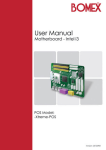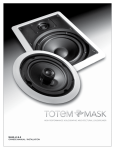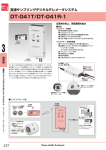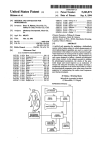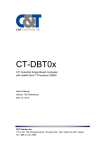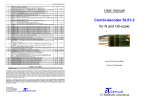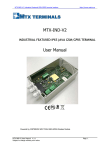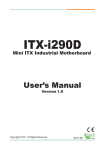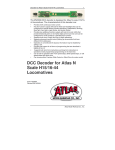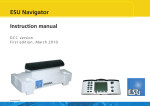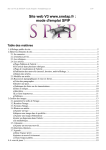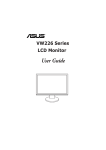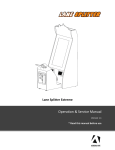Download FCC Information and Copyright
Transcript
FCC Information and Copyright This equipment has been tested and found to comply with the limits of a Class B digital device, pursuant to Part 15 of the FCC Rules. These limits are designed to provide reasonable protection against harmful interference in a residential installation. This equipment generates, uses, and can radiate radio frequency energy and, if not installed and used in accordance with the instructions, may cause harmful interference to radio communications. There is no guarantee that interference will not occur in a particular installation. The vendor makes no representations or warranties with respect to the contents here and specially disclaims any implied warranties of merchantability or fitness for any purpose. Further the vendor reserves the right to revise this publication and to make changes to the contents here without obligation to notify any party beforehand. Duplication of this publication, in part or in whole, is not allowed without first obtaining the vendor’s approval in writing. The content of this user’s manual is subject to be changed without notice and we will not be responsible for any mistakes found in this user’s manual. All the brand and product names are trademarks of their respective companies. Dichiarazione di conformità sintetica Ai sensi dell’art. 2 comma 3 del D.M. 275 del 30/10/2002 Si dichiara che questo prodotto è conforme alle normative vigenti e soddisfa i requisiti essenziali richiesti dalle direttive 2004/108/CE, 2006/95/CE e 1999/05/CE quando ad esso applicabili Short Declaration of conformity We declare this product is complying with the laws in force and meeting all the essential requirements as specified by the directives 2004/108/CE, 2006/95/CE and 1999/05/CE whenever these laws may be applied Table Of Contents FCC Information and Copyright ������������������������������������������������������������������������������� 1 Chapter 1: Introduction ������������������������������������������������������������������������������������������� 3 1.1 Before You Start ������������������� ��������� �������� ��������� ��������� �������� ��������� ��������� ��������� �� ��������� ���� �������� �� 3 1.2 Package Checklist ���������������������� �������� ��������� ��������� ��������� �������� ��������� ��������� ������� ���������� ��� �������� � 3 1.3 Specifications ���� �������� ��������� ��������� ��������� �������� ��������� ��������� �������� ��������� ��������� �� ������� ������ �������� ���� 4 Chapter 2: Hardware installation ����������������������������������������������������������������������������� 9 2.1 Central Processing Unit (CPU) ��������������������������������������������������������������������������������������������� 9 2.2 Connect Cooling Fans ������������������ ��������� ��������� ��������� �������� ��������� ��������� �������� ��������� ������������ � ���� 9 2.3 Installing System Memory �������������������������������������������������������������������������������������������������� 9 2.4 Power Supply ����������������� �������� ��������� ��������� �������� ��������� ��������� ��������� �������� ������ �������� ����� �������� ��� 10 2.5 Jumpers / Headers / Connectors �������������������������������������������������������������������������������������� 11 2.6 Expansion Slots ���������������������� �������� ��������� ��������� �������� ��������� ��������� ��������� �������� ��������� ���� �������� � 18 Chapter 3: BIOS Setup ������������������������������������������������������������������������������������������� 19 3.1 Main Menu ����������������������� ��������� �������� ��������� ��������� ��������� �������� ��������� ��������� � ������ ������� �������� ���� 20 3.2 Advanced Menu ������������������������� ��������� ��������� �������� ��������� ��������� �������� ��������� ����� ��������� ���� �������� 21 3.3 Chipset Menu ������������������������� ��������� ��������� �������� ��������� ��������� ��������� �������� ������ �������� ����� �������� �� 34 3.4 Security Menu ����������������������� �������� ��������� ��������� �������� ��������� ��������� ��������� �������� �������� ����� �������� � 40 3.5 Boot Menu ������������������������ ��������� ��������� �������� ��������� ��������� ��������� �������� ��������� ������ ������� �������� ����� 42 3.6 Exit Menu ������������������������� ��������� �������� ��������� ��������� �������� ��������� ��������� �������� ������ ������� �������� ������� 43 Chapter 4: Useful help ������������������������������������������������������������������������������������������ 44 4.1 Driver Insta lla tion ��������� �������� ��������� ��������� �������� ��������� ��������� �������� ��������� ��������� ���� ��������� ���� ����� 44 4.2 AMI BIOS Beep Code ������������������������� ��������� �������� ��������� ��������� �������� ��������� ��������� ��� ����������� �� �� 45 4.3 AMI BIOS post code ������������������������� �������� ��������� ��������� �������� ��������� ��������� �������� ���� ����������� �� ���� 45 4.4 Troubles hooting ��������� ��������� ��������� �������� ��������� ��������� �������� ��������� ��������� �������� ����� �������� ����� ������� 47 2 | Table Of Contents BIBD-ICP User’s Manual Chapter 1: Introduction 1.1 Before You Start Thank you for choosing our product. Before you start installing the motherboard, please make sure you follow the instructions below: ••• Prepare a dry and stable working environment with sufficient lighting. ••• Always disconnect the computer from power outlet before operation. ••• Before you take the motherboard out from anti-static bag, ground yourself properly by touching any safely grounded appliance, or use grounded wrist strap to remove the static charge. ••• Avoid touching the components on motherboard or the rear side of the board unless necessary. Hold the board on the edge, do not try to bend or flex the board. ••• Do not leave any unfastened small parts inside the case after installation. Loose parts will cause short circuits which may damage the equipment. ••• Keep the computer from dangerous area, such as heat source, humid air and water. ••• The operating temperatures of the computer should be 0 to 45 degrees Celsius. ••• To avoid injury, be careful of: Sharp pins on headers and connectors Rough edges and sharp corners on the chassis Damage to wires that could cause a short circuit 1.2 Package Checklist ••• Mini-ITX Mainboard x 1 ••• Fully Setup Driver DVD x 1 ••• I/O Bracket x 1 ••• SATA Cable x 1 Note »»» The package contents may be different due to the sales region or models in which it was sold. For more information about the standard package in your region, please contact your dealer or sales representative. Chapter 1: Introduction | 3 1.3 Specifications CPU Intel Celerin J1900(2.0GHz@10W) 4T/4C 2M L2 cache Integrated Intel® HD Graphics series graphic engine supports: Graphics Frequency: Intel Graphics HD 321MHz-750MHz Graphic Dual independent displays (Extended mode) as below two: -- Integrated VGA D-Sub -- Integrated LVDS dual channel 18-24Bits support by RTD2136R Realtek FINTEK F81866AD Super I/O Provides the most commonly used legacy Super I/O functionality. 128pin type Environment Control initiatives, H/W Monitor, Fan Speed Controller 2x SO-DIMM (204pin) slot, DDR3L 1333/1066 MHz, Max 8GB Main Memory Registered DIMM or ECC DIMM is not supported * DIMMB1 slot is optional. Chipset built-in Serial ATA controller SATA LAN Sound Codec Expansion Slots SATA Version 2.0 specification compliant Data transfer rates up to 3.0 Gb/s Realtek RTL 8111G 10 / 100 / 1000 Mb/s auto negotiation, Half / Full duplex capability Realtek Codec ALC662, supports Line-out/Mic-in 1x Mini PCI-E slot (Height @ 8mm), Mini PCI-E or mSATA function can be selected by BIOS 1x 2x2 Pin DC Jack 1x DC jack (RJ11), 12V/24V input select by jumper 1x VGA D-Sub 4x USB 2.0 Back Panel I/O 1x RJ-45 (Gigabit LAN) 1x PS2 for KB/Mouse 3x COM - COM1 (RS232/422/485) support RI/5V/2V power select - COM2/3 (RS232), support RI/5/12V power select 1x Audio Connectors (for Line-out/MIC-in) 4 | Chapter 1: Introduction BIBD-ICP User’s Manual SATA 2x SATA II up to 3Gb/s HDD connector (SATA2 is shared with mini PCI-E slot) Display 1x 2*20 pins, LCD LVDS connector support Dual Channel 1x 1*8 pins, LCD Backlight Inverter power connector 1x 1*3 pins, LCD Backlight power select jumper(3.3V/5V) 1x 1*3 pins, LCD Inverter power select jumper(5V/12V) 1x 1*3 pins, Backlight control mode select jumper 1x 1*3 pins, Backlight PWM signal select jumper Speaker 2x 1*2 pins for Amplifier output ALC105 class D 3Watt/Channel Amplifier 1x buzzer On Board Connectors & Headers Power 1x 2*2 pins + 12V DC-in connector(Share with rear DC Jack) 2x 1*4 pins for HDD power 5V I/O 1x 2*5 pins, USB2.0 pin header support 2 USB devices 1x 2*5 pins, USB3.0 pin header support 1 USB device 4x 2*5 pins COM3/4/5/6, RS232, support Ring/5/12V 2*3 pins power select 1x 2*5 pins header, digital IO support 4 in 4 out 1x 2*13 pins, parallel header for printer 2x 1*3 pins, system fan and CPU smart fan header 1x 2*5 pins front panel as Power/Reset/HDD/LAN header 1x 1*6 pins box header, internal cash drawer 1 x 1*6 pins MSR pin header 2 x 1*3 pins jumper, MSR definition change Board Size Operation Temperature Storage Temperature Relative Humidity 1 x 1*6 pins header, SIM card 170 mm (W) x 170 mm (L), Mini-ITX 0°C ~ 60°C -20°C ~ 80°C 10% ~ 90% (non-condensing) Win 7, Win 8, POSReady, Linux Fedora 14, Intel® Embedded Graphics Drivers Version 10 (Support by Intel OS Support EIA IEGD tools) Biostar reserves the right to add or remove support for any OS with or without notice. Chapter 1: Introduction | 5 1.4 Rear Panel Connectors JP2: DC-12V Input Connector Pin 1 2 3 4 Assignment +12V DC_IN +12V DC_IN GND GND COM1 Serial Port Connectors Pin 1 2 3 4 5 6 7 8 9 Assignment Carrier detect (DCD) Received data (RXD) Transmitted data (TXD) Data terminal ready (DTR) Signal ground (GND) Data set ready (DSR) Request to send (RTS) Clear to send (CTS) Ring / 5V / 12V * (selected by BIOS setting) COM2/3 Serial Port Connectors (RS232) Pin 1 2 3 4 5 6 | Chapter 1: Introduction Assignment Carrier detect (DCD) Received data (RXD) Transmitted data (TXD) Data terminal ready (DTR) Signal ground (GND) Pin 6 7 8 9 Assignment Data set ready (DSR) Request to send (RTS) Clear to send (CTS) Ring / 5V / 12V * BIBD-ICP User’s Manual JPC3: COM3 Serial Port Voltage Switch Jumper 2 1 Pin 1-2 Close: Pin9=Ring 4 3 Pin 3-4 Close: Pin9= 5V 6 5 Pin 5-6 Close: Pin9=12V Note »»» Note1: COM1/2 voltage selection is controlled by BIOS setup. Please see page-23 & 24 for detail setting. RJ-11 pin define Pin 1 2 3 4 5 6 Define CASE OPEN2_N CASH1 _P CASE OPEN_N CASH_PWR (12/24V) CASH2_P GND Function Status Pin Control Pin Status Pin --Control Pin --- GPIO S5_25 S0_82 S5_24 --S0_83 --- address (memory space) 0XFED0E1B8 bit0 0XFED0C1D8 bit0 0XFED0E1C8 bit0 --0XFED0C1B8 bit0 --- »»» You could read the address value at dword (32 bits/4 bytes). Chapter 1: Introduction | 7 1.5 Motherboard Layout BUZZ1 VGA1 COM3 JPC3 JHDD1 JHDD2 COMA1 COM2 COM1 JUSB1 CPU_FAN1 JCOMS1 JCOM4 JCOM5 JCOM6 JMSRS1 JMSR1 JMSRS2 JPC4 F_USB1 JPC5 JBLR1 JLV3 JLV2 Note »»» represents the 1st pin. »»» DIMMB1 slot is optional. 8 | Chapter 1: Introduction JLV1 JPC6 JC1 SYS_FAN1 JSIM1 BIBD-ICP User’s Manual Chapter 2: Hardware installation 2.1 Central Processing Unit (CPU) The mainboard includes an onboard Intel® SOC, and a cooler has been installed to provide sufficient cooling. 2.2 Connect Cooling Fans These fan headers support cooling-fans built in the computer. The fan cable and connector may be different according to the fan manufacturer. Connect the fan cable to the connector while matching the black wire to pin#1. CPU_FAN1: CPU fan header SYS_FAN1: System fan header CPU_FAN1 SYS_FAN1 JCFAN1 Pin Assignment 1 Ground 2 Smart Fan Control 3 FAN RPM rate sense JSFAN1 Pin Assignment 1 Ground 2 +12V 3 FAN RPM rate sense Note »»» System Fan Headers support 3-pin head connectors. When connecting with wires onto connectors, please note that the red wire is the positive and should be connected to pin#2, and the black wire is Ground and should be connected to GND. 2.3 Installing System Memory DIMMA1/B1: DDR3L Memory Module (204pin SO-DIMM) Note »»» The DIMM must be installed to DIMMA1 slot first. The DIMMB1 slot is optional. »»» If the DIMM does not go in smoothly, do not force it. Pull it all the way out and try again. Chapter 2: Hardware installation | 9 1. Align a DIMM on the slot such that the notch on the DIMM matches the break on the slot. 2. Insert the DIMM firmly into the slot until the retaining clips snap back in place and the DIMM is properly seated. Memory Capacity DIMM Socket Location DIMMA1 DDR3 Module 512MB/1GB/2GB/4GB DIMMB1 512MB/1GB/2GB/4GB Total Memory Size Max is 8GB 2.4 Power Supply JPWR1: ATX Power Source Connector (4-pin) This connector provides or +12V input to system power circuit. Pin Assignment 1 2 +12V in +12V in 3 Ground 4 Ground JHDD1/JHDD2: HDD Power Connector This connector provides power connection of SATA devices. Pin Assignment 1 +12V output JHDD1 JHDD2 10 | Chapter 2: Hardware installation 2 GND 3 GND 4 +5V output BIBD-ICP User’s Manual 2.5 Jumpers / Headers / Connectors Jumper Setting The illustration shows how to set up jumpers. When the jumper cap is placed on pins, the jumper is “close”, if not, that means the jumper is “open”. Pin opened Pin closed Pin 1-2 closed JCMOS1: Clear CMOS Jumper Placing the jumper on pin2-3 allows user to restore the BIOS safe setting and the CMOS data. Please carefully follow the procedures to avoid damaging the motherboard. 1 3 Pin 1-2 Close: Normal Operation (Default) 1 3 Pin 2-3 Close: Clear CMOS data Clear CMOS Procedures: 1. Remove AC power line. 2. Set the jumper to “Pin 2-3 close”. 3. Wait for five seconds. 4. Set the jumper to “Pin 1-2 close”. 5. Power on the AC. 6. Reset your desired password or clear the CMOS data. JPANEL1: Front Panel Header This 10-pin header includes Power-on, Reset, HDD LED, and Power LED connection. It allows user to connect the system case’s front panel switch functions. Function Pin Assignment N/A 1 Key 3 HD LED+ 5 HD LED- Reset 7 Reset GND Button 9 Reset HDD LED Function Pin Assignment 2 Power LED+ Power 4 Power LED+ LED 6 Power LED- Power 8 Power Button 10 Power GND Chapter 2: Hardware installation | 11 SATA1/2: Serial ATA 3.0 Gb/s Connectors These connectors support the thin Serial ATA cable for primary internal storage devices. Pin Assignment 1 Ground 2 TX+ 3 TX- 4 Ground 5 RX- 6 RX+ 7 Ground »»» SATA2 is optional and shared with Mini PCI-E slot. JUSB1: USB 3.0 Vertical Connector This connector allows you to connect one USB 3.0 port. Pin Assignment 1 RX- Pin 2 Assignment VCC 3 RX+ 4 VCC 5 GND 6 GND 7 TX+ 8 D+ 9 TX- 10 D- »»» This USB 3.0 connector is not backward compatible with USB 2.0 devices. F_USB1: Header for USB 2.0 Ports at Front Panel This header allows you to connect two additional USB 2.0 ports. 9 1 +5V (fused) 2 +5V (fused) 3 USB - 4 USB - 5 USB + 6 USB + Key 10 NC 12 | Chapter 2: Hardware installation BIBD-ICP User’s Manual Serial Port Connectors & Headers JPC4/5/6: JCOM4/5/6 Serial Port Voltage Switch Jumper 2 1 Pin 1-2 Close: Pin9=Ring (Default) 4 3 Pin 3-4 Close: Pin9= 5V 6 2 6 5 1 5 Pin 5-6 Close: Pin9=12V JCOM4/JCOM5/JCOM6: Serial Port Headers JCOM4 JCOM5 2 1 JCOM6 10 9 Pin 1 3 5 7 9 Assignment -PDCD PSOUT data GND -PRTS Ring/ 5V / 12V* Pin 2 4 6 8 10 Assignment PSIN -PDTR -PDSR -PCTS NA JLV1: Backlight Control Mode Selection Jumper Pin 1-2 Closed: Voltage Level Mode Pin 2-3 Closed: PWM Mode (Default) JLV2: LCD Panel Power Select Jumper Pin 1-2 Close: Inverter Power=3.3V (Default) Pin 2-3 Close: Inverter Power=5V Chapter 2: Hardware installation | 13 JLV3: LCD Backlight Inverter Power Select Jumper Pin 1-2 Close: Inverter Power=5V Pin 2-3 Close: Inverter Power=12V (Default) JBLR1: Backlight PWM Signal Select Jumper Pin 1-2 Close: Reverse Pin 2-3 Close: Forward (Default) 14 | Chapter 2: Hardware installation BIBD-ICP User’s Manual LVDS-OUT1: LVDS Connector This connector supports 18/24 bit single-channel panels. 40 2 39 Pin 1 3 5 7 9 11 13 15 17 19 21 23 25 27 29 31 33 35 37 39 Assignment LVDSB_DATA0_N LVDSB_DATA0_P GND LVDSB_DATA1_N LVDSB_DATA1_P GND LVDSB_DATA2_N LVDSB_DATA2_P GND LVDSB_CLK_N LVDSB_CLK_P GND LVDSB_DATA3_N LVDSB_DATA3_P VCC5 LVDSA_DDC_CLK VCC3_3 NC PVDD2, 3.3V/5V (selected by JLV2) PVDD2, 3.3V/5V (selected by JLV2) 1 Pin 2 4 6 8 10 12 14 16 18 20 22 24 26 28 30 32 34 36 38 40 Assignment PVDD2, 3.3V/5V (selected by JLV2) PVDD2, 3.3V/5V (selected by JLV2) GND GND LVDSA_DATA0_N LVDSA_DATA0_P GND LVDSA_DATA1_N LVDSA_DATA1_P GND LVDSA_DATA2_N LVDSA_DATA2_P GND LVDSA_CLK_N LVDSA_CLK_P GND LVDSA_DATA3_N LVDSA_DATA3_P NC LVDSA_DCC_DATA Chapter 2: Hardware installation | 15 JC1: LCD Backlight Inverter Connector Pin 1 2 3 4 5 6 7 8 Assignment 5V/12V* 5V/12V* NC NC Backlight On(5V)/Off(0V) Brightness Adjust (0-5V) GND GND * selected by JLV3 JSPK1/2: Audio Connector RightSpeaker (JSPK1) Pin Assignment 1 SPKRN 2 SPKRP Left Speaker (JSPK2) Pin Assignment 1 SPKLN 2 SPKLP JPRNT1: Printer Port Connector This header allows you to connect printer port on the PC. 1 3 17 Data 7 18 Ground 19 -ACK 20 Ground 21 23 25 Busy PE SCLT 22 24 26 Ground Ground Key 5 7 9 Data 1 Data 2 Data 3 11 Data 4 13 Data 5 16 | Chapter 2: Hardware installation BIBD-ICP User’s Manual JP1: Voltage Switch Jumper for Cash Draw Connector This jumper is for controlling the Pin4 of RJ11 (JRJ11) to switch 12V or 24V. Pin 1-2 Close: Pin4 of RJ11(JRJ11)=24V (Default) Pin 2-3 Close: Pin4 of RJ11(JRJ11)=12V JDIO1: Digital I/O Connector This connector offers 4-pair of digital I/O functions and address is set in BIOS. 2 10 1 9 Pin 1 2 3 4 5 6 7 8 9 10 Assignment 5V DI-01 DO-01 DI-02 DO-02 DI-03 DO-03 DI-04 DO-04 GND address(I/O space) -528H bit23 -528H bit27 -548H bit28 -548H bit29 --- address(memory space) --0XFED0E348 bit 0 -0XFED0E218 bit 0 -0XFED0E168 bit 0 -0XFED0E158 bit 0 -- GPIO -S0_55 S5_40 S0_59 S5_1 S0_92 S5_26 S0_93 S5_27 -- »»» You could read the address value at dword (32 bits/4 bytes). JMSRS1/JMSRS2: MSR Jumper The jumpers enable or disable MSR connector function. 1 3 Pin 1-2 Close: JMSR1 Disabled (Default) JMSRS1 JMSRS2 1 3 Pin 2-3 Close: JMSR1 Enabled Chapter 2: Hardware installation | 17 JMSR1: MSR Connector The mainboard provides MSR connector. 1 Pin 1 2 3 4 5 6 6 Assignment PS2CLK PS2DAT KCLK KDAT GND +5V JSIM1: SIM card header This mainboard is equipped with one SIM card header for Mini PCI-E Slot. 1 18 | Chapter 2: Hardware installation 6 Pin Assignment 1 GND 2 3 UIM_RESET UIM_CLK 4 UIM_DATA 5 UIM_VPP 6 UIM_PWR BIBD-ICP User’s Manual 2.6 Expansion Slots PE1: Mini PCI-E Slot (Height @ 8mm) This mainboard is equipped with 1 Mini PCI-E Slots. Install an Expansion Card You can install your expansion card by following steps: ••• Read the related expansion card’s instruction document before install the expansion card into the computer. ••• Remove your computer’s chassis cover, screws and slot bracket from the computer. ••• Place a card in the expansion slot and press down on the card until it is completely seated in the slot. ••• Secure the card’s metal bracket to the chassis back panel with a screw. ••• Replace your computer’s chassis cover. ••• Power on the computer, if necessary, change BIOS settings for the expansion card. ••• Install related driver for the expansion card. Chapter 2: Hardware installation | 19 Chapter 3: BIOS Setup Introduction The purpose of this manual is to describe the settings in the AMI UEFI BIOS Setup program on this motherboard. The Setup program allows users to modify the basic system configuration and save these settings to NVRAM. UEFI BIOS determines what a computer can do without accessing programs from a disk. This system controls most of the input and output devices such as keyboard, mouse, serial ports and disk drives. BIOS activates at the first stage of the booting process, loading and executing the operating system. Some additional features, such as virus and password protection or chipset fine-tuning options are also included in UEFI BIOS. The rest of this manual will to guide you through the options and settings in UEFI BIOS Setup. Plug and Play Support This AMI UEFI BIOS supports the Plug and Play Version 1.0A specification. EPA Green PC Support This AMI UEFI BIOS supports Version 1.03 of the EPA Green PC specification. ACPI Support AMI ACPI UEFI BIOS support Version 1.0/2.0 of Advanced Configuration and Power interface specification (ACPI). It provides ASL code for power management and device configuration capabilities as defined in the ACPI specification, developed by Microsoft, Intel and Toshiba. PCI Bus Support This AMI UEFI BIOS also supports Version 2.3 of the Intel PCI (Peripheral Component Interconnect) local bus specification. DRAM Support DDR3 SDRAM (Double Data Rate III Synchronous DRAM) is supported. Supported CPUs This AMI UEFI BIOS supports the latest CPU. Using Setup When starting up the computer, press <Del> during the Power-On Self-Test (POST) to enter the UEFI BIOS setup utility. In the UEFI BIOS setup utility, you will see General Help description at the top right corner, and this is providing a brief description of the selected item. Navigation Keys for that particular menu are at the bottom right corner, and you can use these keys to select item and change the settings. Note »»» The default UEFI BIOS settings apply for most conditions to ensure optimum performance of the motherboard. If the system becomes unstable after changing any settings, please load the default settings to ensure system’s compatibility and stability. Use Load Setup Default under the Exit Menu. »»» For better system performance, the UEFI BIOS firmware is being continuously updated. The UEFI BIOS information described in this manual is for your reference only. The actual UEFI BIOS information and settings on board may be slightly different from this manual. »»» The content of this manual is subject to be changed without notice. We will not be responsible for any mistakes found in this user’s manual and any system damage that may be caused by wrong-settings. 20 | Chapter 3: BIOS Setup BIBD-ICP User’s Manual 3.1 Main Menu Once you enter AMI UEFI BIOS Setup Utility, the Main Menu will appear on the screen providing an overview of the basic system information. BIOS Information Shows system information including UEFI BIOS version, model name, marketing name, built date, etc. Memory Frequency Shows the system memory frequency. Total Memory Shows system memory size, VGA shard memory will be excluded. System Date Set the system date. Note that the ‘Day’ automatically changes when you set the date. System Time Set the system internal clock. Access Level Shows the access level of current user. Chapter 3: BIOS Setup | 21 3.2 Advanced Menu The Advanced Menu allows you to configure the settings of CPU, Super I/O, Power Management, and other system devices. Note »»» Beware of that setting inappropriate values in items of this menu may cause system to malfunction. »»» The options and default settings might be different by RAM or CPU models. ACPI Settings Enable ACPI Auto Configuration This item enables or disables BIOS ACPI Auto Configuration. Options: Disabled (Default) / Enabled Enable Hibernation This item enables or disables system ability to hibernate (OS/S4 sleep state)/ This option may be not effective with some OS. Options: Enabled (Default) / Disabled 22 | Chapter 3: BIOS Setup BIBD-ICP User’s Manual ACPI Sleep State This item selects the highest ACPI sleep state the system will enter when the SUSPEND button is pressed. Options: S3 (Suspend to RAM)(Default) / Suspend Disabled Lock Legacy Resources This item enables or disables Lock of Legacy Resources. Options: Disabled (Default) / Enabled Restore AC Power Loss This item enables the system to wake from S5 using Ring-In event. Options: Power Off (Default) / Power On / Last State EuP Control When EuP is enabled, the system will meet EuP requirement. Options: Disabled (Default) / Enabled PME Wake up from S5 This item enables the system to wake from S5 using PEM event. Options: Disabled (Default) / Enabled Wake system with Fixed Time This item enables or disables the system to wake on by alarm event. When this item is enabled, the system will wake on the hr::min::sec specified. Options: Disabled (Default) / Enabled Wake up date You can choose which date the system will boot up. Wake up hour / Wake up minute / Wake up second You can choose the system boot up time, input hour, minute and second to specify. USB Device Wakeup from S3/S4 This item allows you to enable or disabled the USB resume from S3/S4 function. Options: Disabled (Default) / Enabled Ring-In Wake up from S5 This item enables the system to wake from S5 using Ring-In event. Options: Disabled (Default) / Enabled PS2 Keyboard PowerOn This item allows you to control the keyboard power on function. Options: Disabled (Default) / Ctrl + Esc / Ctrl + F1 / Ctrl + Space / Any key / Wake Key / Power Key / Ctrl + Alt + Space / Space PS2 Mouse PowerOn This item allows you to control the mouse power on function. Options: Disabled (Default) / Enabled Chapter 3: BIOS Setup | 23 Super IO Configuration Serial Port 1 Configuration Serial Port This item enables or disables Serial Port (COM). Options: Enabled (Default) / Disabled Change Settings This item selects an optimal setting for Super IO device. Options: Auto (Default) / IO=3F8h; IRQ=4 / IO=3F8h; IRQ= 3,4,5,6,7,9,10,11,12 / IO=2F8h; IRQ= 3,4,5,6,7,9,10,11,12 / IO=3E8h; IRQ= 3,4,5,6,7,9,10,11,12 / IO=2E8h; IRQ= 3,4,5,6,7,9,10,11,12 Serial Port 1 Power This item sets serial port 1 power. Options: Ring / 5V / 12V (Default) 24 | Chapter 3: BIOS Setup BIBD-ICP User’s Manual Serial Port 2 Configuration Serial Port This item enables or disables Serial Port (COM). Options: Enabled (Default) / Disabled Change Settings This item selects an optimal setting for Super IO device. Options: Auto (Default) / IO=2F8h; IRQ=3 / IO=3F8h; IRQ= 3,4,5,6,7,9,10,11,12 / IO=2F8h; IRQ= 3,4,5,6,7,9,10,11,12 / IO=3E8h; IRQ= 3,4,5,6,7,9,10,11,12 / IO=2E8h; IRQ= 3,4,5,6,7,9,10,11,12 Serial Port 2 Power This item sets serial port 1 power. Options: Ring / 5V (Default) / 12V Serial Port 3 Configuration Serial Port This item enables or disables Serial Port (COM). Options: Enabled (Default) / Disabled Chapter 3: BIOS Setup | 25 Change Settings This item selects an optimal setting for Super IO device. Options: Auto (Default) / IO=2C0h; IRQ=6 / IO=2C0h; IRQ= 3,4,5,6,7,9,10,11,12 / IO=2C8h; IRQ= 3,4,5,6,7,9,10,11,12 / IO=2D0h; IRQ= 3,4,5,6,7,9,10,11,12 / IO=2D8h; IRQ= 3,4,5,6,7,9,10,11,12 Serial Port 4 Configuration Serial Port This item enables or disables Serial Port (COM). Options: Enabled (Default) / Disabled Change Settings This item selects an optimal setting for Super IO device. Options: Auto (Default) / IO=2C8h; IRQ=6 / IO=2C0h; IRQ= 3,4,5,6,7,9,10,11,12 / IO=2C8h; IRQ= 3,4,5,6,7,9,10,11,12 / IO=2D0h; IRQ= 3,4,5,6,7,9,10,11,12 / IO=2D8h; IRQ= 3,4,5,6,7,9,10,11,12 Serial Port 5 Configuration Serial Port This item enables or disables Serial Port (COM). Options: Enabled (Default) / Disabled 26 | Chapter 3: BIOS Setup BIBD-ICP User’s Manual Change Settings This item selects an optimal setting for Super IO device. Options: Auto (Default) / IO=2D0h; IRQ=6 / IO=2C0h; IRQ= 3,4,5,6,7,9,10,11,12 / IO=2C8h; IRQ= 3,4,5,6,7,9,10,11,12 / IO=2D0h; IRQ= 3,4,5,6,7,9,10,11,12 / IO=2D8h; IRQ= 3,4,5,6,7,9,10,11,12 Serial Port 6 Configuration Serial Port This item enables or disables Serial Port (COM). Options: Enabled (Default) / Disabled Change Settings This item selects an optimal setting for Super IO device. Options: Auto (Default) / IO=2D8h; IRQ=6 / IO=2C0h; IRQ= 3,4,5,6,7,9,10,11,12 / IO=2C8h; IRQ= 3,4,5,6,7,9,10,11,12 / IO=2D0h; IRQ= 3,4,5,6,7,9,10,11,12 / IO=2D8h; IRQ= 3,4,5,6,7,9,10,11,12 Parallel Port Configuration Parallel Port This item enables or disables Parallel Port (LPT/LPTE). Options: Enabled (Default) / Disabled Chapter 3: BIOS Setup | 27 Change Settings This item allows you to select an optimal setting for Super IO device. Options: Auto (Default) / IO=378h; IRQ=7 / IO=378h; IRQ=5,6,7,9,10,11,12 / IO=278h; IRQ=5,6,7,9,10,11,12 / IO=3BCh; IRQ=5,6,7,9,10,11,12 UART IRQ Mode This item sets PCI IRQ Sharing for OS(EX. Windows) or ISA IRQ for Dos. Options: PCI IRQ Sharing (Default) / ISA IRQ Watch Dog Degree This item allows you to determine the functional degree of Watch Dog. Options: Second (Default) / Minute Watch Dog Timer Options: 0 for disabled (Default) / Min=1, Max=255 H/W Monitor Smart Fan Function This item allows you to control the CPU Smart Fan function. Options: Enabled (Default)/ Disabled 28 | Chapter 3: BIOS Setup BIBD-ICP User’s Manual Smart Fan Mode Configuration CPU_Fan 1 Smart Fan Control This item selects Smart Fan Mode. Options: Manual RPM Mode (Default) / Manual Duty Mode / Auto RPM Mode / Auto Duty_ cycle Mode CPU Configuration Active Processor Cores This item sets number of cores to enable in each processor package. Options: All (Default) / 1 Limit CPUID Maximum When the computer is booted up, the operating system executes the CPUID instruction to identify the processor and its capabilities. Before it can do so, it must first query the processor to find out the highest input value CPUID recognizes. This determines the kind of basic information CPUID can provide the operating system. Options: Disabled (Default) / Enabled Chapter 3: BIOS Setup | 29 Execute-Disable Bit XD can prevent certain classes of malicious buffer overflow attacks when combined with a supporting OS (Windows Server 2003 SP1, Windows XP SP2, SuSE Linux 9.2, RedHat Enterprise 3 Update 3.). Options: Enabled (Default) / Disabled Hardware Prefetcher The processor has a hardware prefetcher that automatically analyzes its requirements and prefetches data and instructions from the memory into the Level 2 cache that are likely to be required in the near future. This reduces the latency associated with memory reads. Options: Enabled (Default) / Disabled Adjacent Cache Line Prefetch The processor has a hardware adjacent cache line prefetch mechanism that automatically fetches an extra 64-byte cache line whenever the processor requests for a 64-byte cache line. This reduces cache latency by making the next cache line immediately available if the processor requires it as well. Options: Enabled (Default) / Disabled Intel Virtualization Technology Virtualization Technology can virtually separate your system resource into several parts, thus enhance the performance when running virtual machines or multi interface systems. Options: Enabled (Default) / Disabled Power Technology This item enables or disables the power management features. Options: Custom (Default) / Disable / Energy Efficient EIST This item enables or disables Intel SpeedSteps. Options: Enabled (Default) / Disabled Turbo Mode This item enables or disables Turbo Mode. Options: Enabled (Default) / Disabled P-STATE Coordination This item changes P-STATE Coordination. Options: HW_ALL (Default) / SW_ALL / SW_ANY CPU C6 Report This item enables or disables CPU C6 (ACPI C3) report to OS. Options: Enabled (Default) / Disabled CPU C7 Report This item enables or disables CPU C7 (ACPI C3) report to OS. Options: Enabled (Default) / Disabled Package C state limit This item enables or disables package C state limit. Options: No Limit (Default) / CO / C1 / C3 / C6 / C7 30 | Chapter 3: BIOS Setup BIBD-ICP User’s Manual PPM Configuration EIST This item enables or disables Intel SpeedSteps. Options: Enabled (Default) / Disabled CPU C state Report This item enables or disables CPU C state report to OS. Options: Enabled (Default) / Disabled Enhanced C state This item enables or disables Enhanced CPU C state. Options: Enabled (Default) / Disabled Max CPU C-state This option controlls Max C state that the processor will support. Options: C7 (Default) / C6 / C1 SATA Configuration Chapter 3: BIOS Setup | 31 Serial-ATA (SATA) This item enables/disables Serial ATA Device. Options: Enabled (Default) / Disabled SATA ODD Port This item selects SATA ODD Port Options: No ODD (Default) / Port0 ODD / Port1 ODD SATA Mode This item determines how SATA controller(s) operate. Options: IDE (Default) / AHCI Serial-ATA Port 1/2 This item enables/disables Serial ATA Port 1/2 Options: Enabled (Default) / Disabled SMART Self Test Run SMART Self Test on all HDDs during POST. Options: Disabled (Default) / Enabled Network Stack Network Stack This item enables or disables UEFI network stack Options: Disabled (Default) / Enabled »»» Note: The following items appear only when you set the Network Stack to [Enabled] IPv4 PXE Support This item enables or disables IPv4 PXE Boot Support. If disabled IPv4 booth option will not be created. Options: Enabled (Default) / Disabled IPv6 PXE Support This item enables or disables IPv6 PXE Boot Support. If disabled IPv6 booth option will not be created. Options: Enabled (Default) / Disabled PXE boot wait time Wait time to press ESC key to abort the PXE boot. 32 | Chapter 3: BIOS Setup BIBD-ICP User’s Manual CSM Configuration CSM Support This item enables or disables CSM Support Options: Enabled (Default) / Disabled GateA20 Active Upon Request – FA20 can be disabled using BIOS services. Always – do not allow disabling GA20; this option is useful when any RT code is executed above 1MB Options: Upon Request (Default) / Always Option ROM Messages This item sets the display mode for option ROM. Options: Force BIOS (Default) / Keep Current INT19 Trap Response BIOS reaction on INT19 trapping by Option ROM: IMMEDIATE – execute the trap right away; POSTPONED – execute the trap during legacy boot. Options: Immediate (Default) / Postponed Boot option filter This option controls what devices system can boot to. Options: Legacy only (Default) / UEFI and Legacy / UEFI only Network This option controls the execution of UEFI and Legacy PXE OpROM Options: Legacy only (Default) / Do not launch / UEFI only / Legacy first / UEFI first Storage This option controls the execution of UEFI and Legacy Storage OpROM Options: Legacy only (Default) / Do not launch / UEFI only / Legacy first / UEFI first Video This option controls the execution of UEFI and Legacy Video OpROM Options: Legacy only (Default) / Do not launch / UEFI only / Legacy first / UEFI first Other PCI devices For PCI devices other than Network, Mass storage or video defines which OpROM to launch. Options: Legacy only (Default) / UEFI first Chapter 3: BIOS Setup | 33 USB Configuration Legacy USB Support This item determines if the BIOS should provide legacy support for USB devices like the keyboard, mouse, and USB drive. This is a useful feature when using such USB devices with operating systems that do not natively support USB (e.g. Microsoft DOS or Windows NT). Options: Enabled (Default) / Disabled / Auto XHCI Hand-Off This is a workaround for OSes without XHCI hand-off support. The XHCI ownership change should be claimed by XHCI driver. Options: Enabled (Default) / Disabled EHCI Hand-Off This is a workaround for OSes without EHCI hand-off support. The EHCI ownership change should be claimed by EHCI driver. Options: Disabled (Default) / Enabled USB Mass Storage Driver Support The item allows you to enable or disable USB Mass Storage Driver Support. Options: Enabled (Default) / Disabled USB transfer time-out The time-out value for Control, Bulk, and Interrupt transfers. Options: 20 sec (Default) / 1 sec / 5 sec / 10 sec Device reset time-out The item sets USB mass storage device Start Unit command timeout. Options: 20 sec (Default) / 10 sec / 30 sec / 40 sec Device power-up delay “Auto” uses default value: for a Root port it is 100ms, for a Hub port the delay is taken from Hub descriptor. Options: Auto (Default) / Manual Device power-up delay in seconds Delay range is 1 ~ 40 seconds, in one second increments. Options: 5 (Default) 34 | Chapter 3: BIOS Setup BIBD-ICP User’s Manual 3.3 Chipset Menu This section describes configuring the PCI bus system. PCI, or Personal Computer Interconnect, is a system which allows I/O devices to operate at speeds nearing the speed of the CPU itself uses when communicating with its own special components. Note »»» Beware of that setting inappropriate values in items of this menu may cause system to malfunction. North Bridge Chapter 3: BIOS Setup | 35 Intel IGD Configuration Integrated Graphics Device Enable: Enable Integrated Graphics Device (IGD) when selected as the Primary Video Apaptor. Disable: Always disable IGD. Options: Enabled (Default) / Disabled IGD Turbo Enable Enable: Enable IGD Turbo Enable. Disable: Enable IGD Turbo Disable. Options: Enabled (Default) / Disabled Primary Display This item selects which of IGD/PCI Graphics device should be Primary Display. Options: IGD (Default) / Auto / PCI / SG GFX Boost This item enables or disables GFX Boost. Options: Disabled (Default) / Enabled PAVC This item enables or disables Protected Audio Video Control Options: LITE Mode (Default) / Disabled / SERPENT Mode DVMT Pre-Allocated This item selects DVMT 5.0 Pre-Allocated (Fixed) Graphics Memory size used by the Internal Graphics Device. Options: 64M (Default) / 96M / 128M / 160M / 192M / 224M / 256M / 288M / 320M / 352M / 384M / 416M / 448M / 480M / 512M DVMT Total Gfx Mem This item selects DVMT5.0 Total Graphic Memory size used by the Internal Graphics Device. Options: 256MB (Default) / 128MB / MAX Aperture Size This item selects the Aperature Size. Options: 256MB (Default) / 128MB / 512MB GTT Size This item selects the GTT Size. Options: 2MB (Default) / 1MB 36 | Chapter 3: BIOS Setup BIBD-ICP User’s Manual VCC_Vnn Config for Power state2 This item enables or disables Vcc Vnn Config for power state2 Options: Disabled (Default) / Enabled RC6 (Render Standby) This item enables or disables render standby support. Options: Enabled (Default) / Disabled LCD Control Boot Display Device This item allows you to select the display device. Options: Auto (Default) / D-SUB / LVDS LCD Panel Type This item selects the LCD panel type. Options: 1440 x 900 2CH (Default) / 800 x 600 1CH / 1024 x 768 1CH / 1280 x 1024 2CH / 1366 x 768 1CH / 1600 x 900 2CH / 1600 x 1200 2CH / 1920 x 1080 2CH / 1920 x1200 2CH LVDS Output This item selects the LVDS Output is 18 or 24 Bit. Options: 24 BIT (Default) / 18 BIT Panel backlinght brightness This item selects the LVDS panel brightness. Options: 5 (Default) Max TOLUD This item sets maxium value of TOLUD. Options: Dynamic (Default) / 1GB / 1.25GB / 1.5GB / 1.75GB / 2GB / 2.25GB / 2.5GB / 2.75GB / 3GB Chapter 3: BIOS Setup | 37 South Bridge Azalia HD Audio Azalia Controller This item controls detection of the Azalia device. Disabled = Azalia will be unconditionally disabled. Enabled = Azalia will be unconditionally Enabled. Auto = Azalia will be enabled if present, disabled otherwise. Options: Enabled (Default) / Disabled Audio AMP output This item selects Audio AMP output dB value. Options: 11dB (Default) / 14dB / 19dB / 25dB 38 | Chapter 3: BIOS Setup BIBD-ICP User’s Manual USB Configuration XHCI Mode The item selects Mode of operation of xHCI controller. Options: Smart Auto (Default) / Auto / Enabled / Disabled USB 2.0(EHCI) Support This item controls the USB EHCI (USB 2.0) functions. One EHCI controller must always be enabled. Options: Disabled (Default) / Enabled »»» Note: The following items appear only when you set the USB 2.0(EHCI) Support to [Enabled] USB RMH Mode This item enables or disables PCH USB Rate Matching Hubs mode. Options: Enabled (Default) / Disabled USB ECHI jebug This item enables or disables PCH EHCI debug capability. Options: Disabled (Default) / Enabled USB Per Port Control Control each of the USB ports (0-3). Enable: Enable USB per port; Disable: Use USB port X settings. Options: Enabled (Default) / Disabled USB Port 0/1/2/3 This item enables or disables USB Port 0. Options: Enabled (Default) / Disabled Chapter 3: BIOS Setup | 39 PCI Express Configuration Onboard LAN This item enables or disables Onboard PCIE LAN. Options: Enabled (Default) / Disabled Onboard LAN Ootion ROM This item enables or disables the Boot Option for Legacy Network Devices. Options: Disabled (Default) / Enabled High Precision Timer This item enables or disables the High Precision Event Timer. Options: Enabled (Default) / Disabled 40 | Chapter 3: BIOS Setup BIBD-ICP User’s Manual 3.4 Security Menu Administrator Password This item sets Administrator Password. User Password This item sets User Password. Secure Boot Secure Boot can be enabled if 1. System running in user mode with enrolled Platform Key(PK) 2.CSM function is disabled. Options: Disable (Default) / Enabled »»» Note: The following items appear only when you set the Secure Boot Mode function to [Custom] Chapter 2: Hardware installation | 41 Key Management Enroll All Factory Default Keys It allows you to immediately load/clear the default Security Boot keys, Platform key (PK), Key-exchange Key (KEK), Signature database (db), and Revoked Signatures (dbx). The Platform Key (PK) state will change from Unloaded mode to Loaded mode. The settings are applied after reboot or at the next reboot. Platform Key (PK) Delete PK – Allows you to delete the PK file from your system. Set new PK – Allows you set new PK file. Key Exchange Key Database (KEK) Delete KEK – Allows you to delete the KEK file from your system. Set new KEK – Allows you set new KEK file. Append Var to KEK – Allows you append Var to KEK. Authorized Signature Database (DB) Delete DB – Allows you to delete the DB file from your system. Set new DB – Allows you set new DB file. Append Var to DB – Allows you append Var to DB. Authorized Timestamps Database (DBT) Delete DBT – Allows you to delete the DBT file from your system. Set new DBT – Allows you set new DBT file. Append Var to DBT – Allows you append Var to DBT. Forbidden Signature Database (DBX) Delete DBX – Allows you to delete the DBX file from your system. Set new DBX – Allows you set new DBK file. Append Var to DBX – Allows you append Var to DBX. 42 | Chapter 2: Hardware installation BIBD-ICP User’s Manual 3.5 Boot Menu This menu allows you to setup the system boot options. Setup Prompt Timeout This item sets number of seconds to wait for setup activation key. Options: 2 (Default) Bootup NumLock State This item selects the keyboard NumLock state. Options: On (Default) / Off Full Screen Logo Display This item allows you to enable/disable Full Screen Logo Show function. Options: Disabled (Default) / Enabled Boot Success Beep When this item is set to Enabled, BIOS will let user know boot success with beep. Options: Enabled (Default) / Disabled Boot Option The items specify the boot device priority sequence from the available devices. The number of device items that appears on the screen depends on the number of devices installed in the system. Chapter 2: Hardware installation | 43 3.6 Exit Menu This menu allows you to load the optimal default settings, and save or discard the changes to the BIOS items. Discard Changes and Exit Abandon all changes made during the current session and exit setup. Save Changes and Reset Reset the system after saving the changes. Restore Defaults This selection allows you to reload the BIOS when problem occurs during system booting sequence. These configurations are factory settings optimized for this system. 44 | Chapter 2: Hardware installation BIBD-ICP User’s Manual Chapter 4: Useful help 4.1 Driver Installation After you installed your operating system, please insert the Fully Setup Driver DVD into your optical drive and install the driver for better system performance. You will see the following window after you insert the DVD The setup guide will auto detect your motherboard and operating system. Note »»» If this window didn’t show up after you insert the Driver DVD, please use file browser to locate and execute the file SETUP.EXE under your optical drive. A. Driver Installation To install the driver, please click on the Driver icon. The setup guide will list the compatible driver for your motherboard and operating system. Click on each device driver to launch the installation program. B. Software Installation To install the software, please click on the Software icon. The setup guide will list the software available for your system, click on each software title to launch the installation program. C. Manual Aside from the paperback manual, we also provide manual in the Driver DVD. Click on the Manual icon to browse for available manual. Note »»» You will need Acrobat Reader to open the manual file. Please download the latest version of Acrobat Reader software from http://www.adobe.com/products/acrobat/readstep2.html Chapter 4: Useful help | 45 4.2 AMI BIOS Beep Code Boot Block Beep Codes Number of Beeps Continuing Description Memory sizing error or Memory module not found POST BIOS Beep Codes Number of Beeps 1 8 Description Success booting. Display memory error (system video adapter) 4.3 AMI BIOS post code Checkpoint Description Disable NMI, Parity, video for EGA, and DMA controllers. Initialize BIOS, POST, Runtime data area. Also 03 initialize BIOS modules on POST entry and GPNV area. Initialized CMOS as mentioned in the Kernel Variable “wCMOSFlags.” Check CMOS diagnostic byte to determine if battery power is OK and CMOS checksum is OK. Verify CMOS checksum manually by reading storage area. If the CMOS checksum is bad, update CMOS with power-on 04 default values and clear passwords. Initialize status register A. Initializes data variables that are based on CMOS setup questions. Initializes both the 8259 compatible PICs in the system 05 Initializes the interrupt controlling hardware (generally PIC) and interrupt vector table. Do R/W test to CH-2 count reg. Initialize CH-0 as system timer. Install the POSTINT1Ch handler. Enable IRQ-0 06 in PIC for system timer interrupt. Traps INT1Ch vector to “POSTINT1ChHandlerBlock.” 07 Fixes CPU POST interface calling pointer. Initializes the CPU. The BAT test is being done on KBC. Program the keyboard controller command byte is 08 being done after Auto detection of KB/MS using AMI KB-5. C0 Early CPU Init Start -- Disable Cache – Init Local APIC. C1 Set up boot strap processor Information. C2 Set up boot strap processor for POST. C5 Enumerate and set up application processors. C6 Re-enable cache for boot strap processor. C7 Early CPU Init Exit. 0A Initializes the 8042 compatible Key Board Controller. 0B Detects the presence of PS/2 mouse. 0C Detects the presence of Keyboard in KBC port. Testing and initialization of different Input Devices. Also, update the Kernel Variables. 0E Traps the INT09h vector, so that the POST INT09h handler gets control for IRQ1. Uncompress all available language, BIOS logo, and Silent logo modules. 13 Early POST initialization of chipset registers. 20 Relocate System Management Interrupt vector for all CPU in the system. 24 Uncompress and initialize any platform specific BIOS modules. GPNV is initialized at this checkpoint. Initializes different devices through DIM. 2A See DIM Code Checkpoints section of document for more information. Initializes different devices. Detects and initializes the video adapter installed in the system that have optional 2C ROMs. 2E Initializes all the output devices. Allocate memory for ADM module and uncompress it. Give control to ADM module for initialization. Initialize 31 language and font modules for ADM. Activate ADM module. 33 Initializes the silent boot module. Set the window for displaying text information. 37 Displaying sign-on message, CPU information, setup key message, and any OEM specific information. Initializes different devices through DIM. See DIM Code Checkpoints section of document for more information. 38 USB controllers are initialized at this point. 39 Initializes DMAC-1 & DMAC-2. 3A Initialize RTC date/time. Test for total memory installed in the system. Also, Check for DEL or ESC keys to limit memory test. Display 3B total memory in the system. 3C Mid POST initialization of chipset registers. 46 | Chapter 4: Useful help BIBD-ICP User’s Manual Checkpoint Description Detect different devices (Parallel ports, serial ports, and coprocessor in CPU, etc.) successfully installed in the 40 system and update the BDA, EBDA…etc. Updates CMOS memory size from memory found in memory test. Allocates memory for Extended BIOS 52 Data Area from base memory. Programming the memory hole or any kind of implementation that needs an adjustment in system RAM size if needed. 60 Initializes NUM-LOCK status and programs the KBD typematic rate. 75 Initialize Int-13 and prepare for IPL detection. 78 Initializes IPL devices controlled by BIOS and option ROMs. 7C Generate and write contents of ESCD in NVRam. 84 Log errors encountered during POST. 85 Display errors to the user and gets the user response for error. 87 Execute BIOS setup if needed / requested. Check boot password if installed. 8C Late POST initialization of chipset registers. 8D Build ACPI tables (if ACPI is supported). 8E Program the peripheral parameters. Enable/Disable NMI as selected. Initialization of system management interrupt by invoking all handlers. Please note this checkpoint comes right 90 after checkpoint 20h. A1 Clean-up work needed before booting to OS. Takes care of runtime image preparation for different BIOS modules. Fill the free area in F000h segm ent with A2 0FFh. Initializes the Microsoft IRQ Routing Table. Prepares the runtime language module. Disables the system configuration display if needed. A4 Initialize runtime language module. Display boot option popup menu. Displays the system configuration screen if enabled. Initialize the CPU’s before boot, which includes the A7 programming of the MTRR’s. A9 Wait for user input at config display if needed. AA Uninstall POST INT1Ch vector and INT09h vector. AB Prepare BBS for Int 19 boot. Init MP tables. AC End of POST initialization of chipset registers. De-initializes the ADM module. B1 Save system context for ACPI. Prepare CPU for OS boot including final MTRR values. 00 Passes control to OS Loader (typically INT19h). Chapter 4: Useful help | 47 4.4 Troubleshooting Probable 1. There is no power in the system. Power LED does not shine; the fan of the power supply does not work 2. Indicator light on keyboard does not shine. System is inoperative. Keyboard lights are on, power indicator lights are lit, and hard drives are running. Solution 1. Make sure power cable is securely plugged in. 2. Replace cable. 3. Contact technical support. Using even pressure on both ends of the DIMM, press down firmly until the module snaps into place. 1. Check cable running from disk to disk controller board. Make sure both ends are securely plugged in; System does not boot from a hard disk drive, but can check the drive type in the standard CMOS setup. be booted from optical drive. 2. Backing up the hard drive is extremely important. All hard disks are capable of breaking down at any time. System only boots from an optical drive. Hard disks 1. Back up data and applications files. can be read, applications can be used, but system 2. Reformat the hard drive. Re-install applications fails to boot from a hard disk. and data using backup disks. Screen message shows “Invalid Configuration” or Review system’s equipment. Make sure correct “CMOS Failure.” information is in setup. 1. Set master/slave jumpers correctly. System cannot boot after user installs a second hard 2. Run SETUP program and select correct drive types. drive. Call the drive manufacturers for compatibility with other drives. CPU Overheated If the system shutdown automatically after power on system for seconds, that means the CPU protection function has been activated. When the CPU is over heated, the motherboard will shutdown automatically to avoid a damage of the CPU, and the system may not power on again. In this case, please double check: 1. The CPU cooler surface is placed evenly with the CPU surface. 2. CPU fan is rotated normally. 3. CPU fan speed is fulfilling with the CPU speed. After confirmed, please follow steps below to relief the CPU protection function. 1. Remove the power cord from power supply for seconds. 2. Wait for seconds. 3. Plug in the power cord and boot up the system. Or you can: 1. Clear the CMOS data. (See “Close CMOS Header: JCMOS1” section) 2. Wait for seconds. 3. Power on the system again. »»» Release Date: 2015/03/13 48 | Chapter 4: Useful help




















































